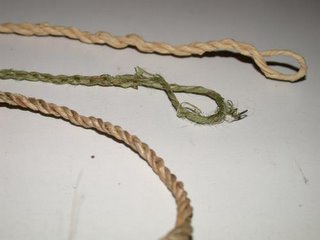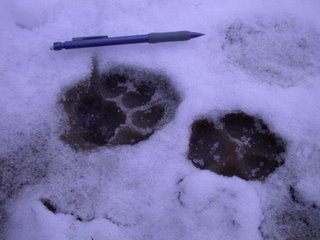With the fibers processed we were ready to make cordage. The technique we used is called the reverse wrap. Taking two groups of strands you hold them from the end (or fold a group of strands in the middle and use the two halves), take the top bundle and twist it away from you than wrap it under the bottom bundle and repeat (now with the bundle that was originally on the bottom). The idea is that the twisted fibers are going against the direction of the wrapping so they won't unravel on their own very easily. You can also do reverse wrap with more than two bunches using the same process of taking the top one, twisting it and moving it to the bottom.
 I made the top cord with some arts and crafts grass that the instructors gave us to practice with, the second cord is out of a stalk of nettle I processed and the third is a triple reverse wrap using strands of cattail. I was able to break the cattail cord with a fairly strong pull. Pulling as hard as I could, I was unable to break the grass or the nettle cord, though with two of us pulling pretty hard we managed to break the nettle (we didn't try that with the grass).
I made the top cord with some arts and crafts grass that the instructors gave us to practice with, the second cord is out of a stalk of nettle I processed and the third is a triple reverse wrap using strands of cattail. I was able to break the cattail cord with a fairly strong pull. Pulling as hard as I could, I was unable to break the grass or the nettle cord, though with two of us pulling pretty hard we managed to break the nettle (we didn't try that with the grass). The top/left track is from the cougar that I was wrote about on the first. The bottom/right track is from the dog we were out with (a medium-large mutt). Though the picture isn't great for details, I can clearly see two of the major cougar vs. dog differentiators and can sort of see two others.
The top/left track is from the cougar that I was wrote about on the first. The bottom/right track is from the dog we were out with (a medium-large mutt). Though the picture isn't great for details, I can clearly see two of the major cougar vs. dog differentiators and can sort of see two others.
No comments:
Post a Comment